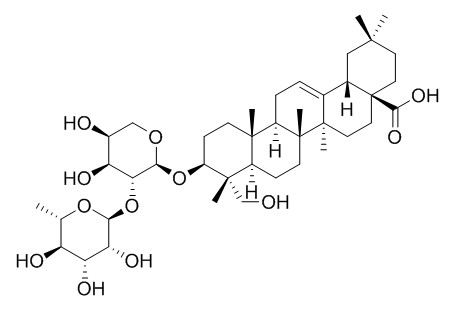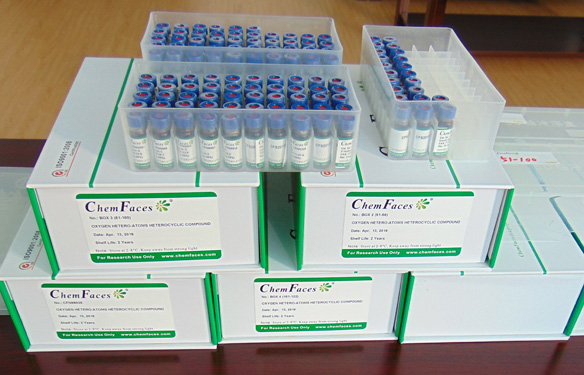alpha-Hederin
alpha-Hederin possesses several biological properties such as antispasmodic, moliscicidic, anthelmithic and inhibiting cell proliferation, it exhibits a strong antiproliferative activity on all stages of development of the parasite by altering membrane integrity and potential in Leishmania. alpha-Hederin has anti-oxidant activity and acute anti-inflammatory activity in carrageenan-induced rat paw edema. alpha-Hederin can increase isoprenaline-induced relaxation indirectly, probably by inhibiting heterologous desensitization induced by high concentrations of muscarinic ligands like.
Inquire / Order:
manager@chemfaces.com
Technical Inquiries:
service@chemfaces.com
Tel:
+86-27-84237783
Fax:
+86-27-84254680
Address:
1 Building, No. 83, CheCheng Rd., Wuhan Economic and Technological Development Zone, Wuhan, Hubei 430056, PRC
Providing storage is as stated on the product vial and the vial is kept tightly sealed, the product can be stored for up to
24 months(2-8C).
Wherever possible, you should prepare and use solutions on the same day. However, if you need to make up stock solutions in advance, we recommend that you store the solution as aliquots in tightly sealed vials at -20C. Generally, these will be useable for up to two weeks. Before use, and prior to opening the vial we recommend that you allow your product to equilibrate to room temperature for at least 1 hour.
Need more advice on solubility, usage and handling? Please email to: service@chemfaces.com
The packaging of the product may have turned upside down during transportation, resulting in the natural compounds adhering to the neck or cap of the vial. take the vial out of its packaging and gently shake to let the compounds fall to the bottom of the vial. for liquid products, centrifuge at 200-500 RPM to gather the liquid at the bottom of the vial. try to avoid loss or contamination during handling.
Molecules.2017, 22(6)
Front Pharmacol.2022, 13:972825.
Phytomedicine.2022, 100:154058.
Pharm Biol.2021, 59(1):134-145.
Heliyon.2023, 9(6):e16138.
Planta Med.2024, 2328-2750
Clin Exp Pharmacol Physiol.2020, doi: 10.1111
Phytomedicine.2023, 120:155063.
Environ Toxicol.2019, 34(12):1354-1362
Molecules.2019, 24(19):E3417
Related and Featured Products
Int J Oncol. 2014 Aug;45(2):757-63.
The anticancer effect and mechanism of α-hederin on breast cancer cells.[Pubmed:
24842044]
Natural plant products occupy a very important position in the area of cancer chemotherapy. Many triterpenoid saponins have been proved as potential agents for chemoprevention and therapy of breast cancer.
alpha-Hederin, a monodesmosidic triterpenoid saponin distributed in Hedera or Nigella species, displays many biological activities. It is increasingly investigated for its promising anticancer potential since it has been shown to have cytotoxicity against several types of cancer cells. However, studies of alpha-Hederin on breast cancer are limited, most of which focus on biological activity, while the mechanisms have not been widely reported yet. Previously, we purified and identified alpha-Hederin from Clematis ganpiniana, a herb used in traditional Chinese medicine with antitumor action.
CONCLUSIONS:
In the present study, alpha-Hederin showed strong inhibitory activity on the growth of breast cancer cells and induced apoptosis in these cells. alpha-Hederin induced depolarization of mitochondrial membrane potential which released Apaf-1 and cytochrome c from the intermembrane space into the cytosol, where they promoted caspase-3 and caspase-9 activation.
CONCLUSIONS:
This is the first report on the growth inhibition and pro-apoptotic effects of alpha-Hederin on breast cancer cells and the relative apoptosis pathways. It implied that triterpenoid saponin alpha-Hederin could be a promising candidate for chemotherapy of breast cancer.
Phytochemistry. 2014 May;101:116-20.
The haploinsufficiency profile of α-hederin suggests a caspofungin-like antifungal mode of action.[Pubmed:
24569176 ]
The leaves of common ivy (Hedera helix) contain the cytotoxic saponin alpha-Hederin, which is inhibitory to Candida albicans at low concentrations.
METHODS AND RESULTS:
To investigate the mode of action of alpha-Hederin, a haploinsufficiency screen was carried out using a library of 1152 Saccharomyces cerevisiae deletion strains. An ethanol ivy extract containing alpha-Hederin was used in the initial screen to reduce the amount of compound required. Strains exhibiting disproportionately low growth were then examined in more detail by comparing growth curves in the presence and absence of alpha-Hederin. This approach identified three hypersensitive strains carrying gene deletions for components of the transcription related proteins SWI/SNF, RNA polymerase II and the RSC complex. Saponin cytotoxicity is often attributed to membrane damage, however alpha-Hederin did not induce hypersensitivity with an aminophospholipid translocase deletion strain that is frequently hypersensitive to membrane damaging agents.
CONCLUSIONS:
The haploinsufficiency profile of alpha-Hederin is most similar to that reported for drugs such as caspofungin that inhibit synthesis of the fungal cell wall.
Planta Med. 2004 Jun;70(6):561-3.
Antioxidant activity of saponins isolated from ivy: alpha-hederin, hederasaponin-C, hederacolchiside-E and hederacolchiside-F.[Pubmed:
15241892]
The antioxidant activities of alpha-Hederin and hederasaponin-C from Hedera helix, and hederacolchisides-E and -F from Hedera colchica were investigated, in this study.
METHODS AND RESULTS:
The antioxidant properties of the saponins were evaluated using different antioxidant tests: 1,1-di-phenyl-2-picryl-hydrazyl (DPPH.) free radical scavenging, total antioxidant activity, reducing power, superoxide anion radical scavenging, hydrogen peroxide scavenging, and metal chelating activities. alpha-Hederin, hederasaponin-C, as well as hederacolchisides-E and -F exhibited a strong total antioxidant activity. At the concentration of 75 pg/mL, these saponins showed 94, 86, 88 and 75% inhibition on lipid peroxidation of linoleic acid emulsion,respectively.
CONCLUSIONS:
These various antioxidant activities were compared with model antioxidants such as a-tocopherol, butylated hydroxyanisole (BHA) and butylated hydroxytoluene (BHT).
Planta Med. 2000 May;66(4):343-7.
Antileishmanial activity of three saponins isolated from ivy, alpha-hederin, beta-hederin and hederacolchiside A1, as compared to their action on mammalian cells cultured in vitro.[Pubmed:
10865451]
The in vitro antileishmanial activity of three saponins isolated from ivy, alpha-Hederin, beta-hederin and hederacolchiside A1, was investigated on Leishmania infantum.
METHODS AND RESULTS:
The assessment of possible targets (membrane integrity, membrane potential, DNA synthesis and protein content) was performed in both Leishmania promastigotes and human monocytes (THP1 cells). Results observed in Leishmania showed that the saponins exhibited a strong antiproliferative activity on all stages of development of the parasite by altering membrane integrity and potential: hederacolchiside A1 appeared to be the most active compound against both promastigotes and amastigotes.
CONCLUSIONS:
Results observed in THP1 cells demonstrated that the saponins exerted also a potent antiproliferative activity against human monocytes, by producing a significant DNA synthesis inhibition. The ratio between antileishmanial activity on amastigotes and toxicity to human cells suggested that the saponins could be considered as possible antileishmanial drugs.
Phytother Res . 2020 Mar;34(3):601-611.
α-Hederin induces the apoptosis of gastric cancer cells accompanied by glutathione decrement and reactive oxygen species generation via activating mitochondrial dependent pathway[Pubmed:
31777126]
Abstract
α-Hederin, a monodesmosidic triterpenoid saponin, exhibited promising antitumor potential against a variety of human cancer cell lines. However, few related studies about effects of α-hederin on gastric cancer are available. Herein, our results showed that α-hederin significantly inhibited the proliferation of gastric cancer cells and arrested the cell cycle in G1 phase in vitro (p < .05). Further research of the potential mechanism reflected that α-hederin could induce intracellular glutathione decrement, adenosine triphosphate level, and mitochondrial membrane potential variation via inducing reactive oxygen species accumulation during the apoptosis of gastric cancer cells. Moreover, the detection of mitochondrial and cytosol proteins with apoptosis-inducing factor, apoptosis protease activating factor-1, and cytochrome C showed an increase in the cytosol, followed by a decrease of Bcl-2 levels and increases of caspase-3, caspase-8, caspase-9, and Bax, which revealed that α-hederin induced apoptosis via triggering activation of the mitochondrial pathway. Furthermore, the above changes were amplified when pretreated with buthionine sulfoximine, whereas attenuated in the group pretreated with NAC than α-hederin alone (p < .05). In addition, α-hederin significantly inhibited the growth of xenografted gastric tumors with favorable safety. In conclusion, α-hederin could inhibit the proliferation and induce apoptosis of gastric cancer accompanied by glutathione decrement and reactive oxygen species generation via activating mitochondrial dependent pathway.
Keywords: apoptosis; gastric cancer; glutathione (GSH); mitochondria; reactive oxygen species (ROS); α-hederin.
Biochemistry. 2009 Apr 21;48(15):3477-82.
Alpha-hederin, but not hederacoside C and hederagenin from Hedera helix, affects the binding behavior, dynamics, and regulation of beta 2-adrenergic receptors.[Pubmed:
19278262 ]
Hederacoside C, alpha-Hederin, and hederagenin are saponins of dry extracts obtained from the leaves of ivy (Hedera helix L.).
METHODS AND RESULTS:
Internalization of beta(2)-adrenergic receptor-GFP fusion proteins after stimulation with 1 microM terbutaline was inhibited by preincubation of stably transfected HEK293 cells with 1 microM alpha-Hederin for 24 h, whereas neither hederacoside C nor hederagenin (1 microM each) influenced this receptor regulation. After incubation of A549 cells with 5 nM Alexa532-NA, two different diffusion time constants were found for beta(2)AR-Alexa532-NA complexes by fluorescence correlation spectroscopy. Evaluation of the autocorrelation curve revealed diffusion time constants: tau(bound1) = 1.4 +/- 1.1 ms (n = 6) found for receptor-ligand complexes with unrestricted lateral mobility, and tau(bound2) = 34.7 +/- 14.1 ms (n = 6) for receptor-ligand complexes with hindered mobility. The distribution of diffusion time constants was 24.3 +/- 2.5% for tau(bound1) and 8.7 +/- 4.3% for tau(bound2) (n = 6). A549 cells pretreated with 1 microM alpha-Hederin for 24 h showed dose-dependent alterations in this distribution with 37.1 +/- 5.5% for tau(bound1) and 4.1 +/- 1.1% for tau(bound2).
Simultaneously, the level of Alexa532-NA binding was significantly increased from 33.0 +/- 6.8 to 41.2 +/- 4.6%. In saturation experiments, alpha-Hederin did not influence the beta(2)-adrenergic receptor density (B(max)), whereas the K(D) value for Alexa532-NA binding decreased from 36.1 +/- 9.2 to 24.3 +/- 11.1 nM. Pretreatment of HASM cells with alpha-Hederin (1 microM, 24 h) revealed an increased intracellular cAMP level of 13.5 +/- 7.0% under stimulating conditions. Remarkably, structure-related saponins like hederacoside C and hederagenin did not influence either the binding behavior of beta(2)AR or the intracellular cAMP level.
Mutagenesis. 1996 Mar;11(2):161-7.
Protective effects of alpha-hederin, chlorophyllin and ascorbic acid towards the induction of micronuclei by doxorubicin in cultured human lymphocytes.[Pubmed:
8671733]
The influence of alpha-Hederin (a saponin isolated from Hedera helix), chlorophyllin, the sodium-copper salt of chlorophyll, and ascorbic acid (vitamin C) on the direct clastogenicity of doxorubicin (Adriamycin) was investigated in vitro in human lymphocytes for the induction of micronuclei.
In order to determine a possible mechanism of action responsible for the antimutagenic activity, treatments were performed for the three substances at different times of the culture (pre-treatment, simultaneous and post-treatment).
METHODS AND RESULTS:
alpha-Hederin (1.3 x 10(-2), 0.13, 1.3 and 13 nmol/ml) and chlorophyllin (0.14, 1.4 and 14 nmol/ml) were found to exert an antimutagenic effect against the clastogenicity of doxorubicin (1.5 x 10(-2) nmol/ml) in all treatments at all concentrations. Ascorbic acid (10 nmol/ml) was effective in reducing the micronucleus levels only in the simultaneous treatment, when it was previously incubated with doxorubicin for 2 h at 37 degrees C before being introduced into the culture.
CONCLUSIONS:
Our results suggested a desmutagenic effect for alpha-Hederin, chlorophyllin and ascorbic acid. Chlorophyllin acted also through a bio-antimutagenic mechanism and alpha-Hederin seemed to induce metabolic enzymes, which inactivated doxorubicin. Preliminary studies showed that the effective antimutagenic concentrations of alpha-Hederin, chlorophyllin and ascorbic acid had no clastogenic or aneugenic effects in human lymphocytes. No cytotoxicity was observed for the three antimutagenic agents either.
Phytother Res. 2008 Oct;22(10):1299-302.
Alpha-hederin potentiates 5-FU antitumor activity in human colon adenocarcinoma cells.[Pubmed:
18546204 ]
The aim of this study was to investigate the ability of alpha-Hederin to improve the efficacy of widely prescribed 5-fluorouracil (5-FU) in a human colon adenocarcinoma model.
METHODS AND RESULTS:
Drug combinations of alpha-Hederin and 5-FU using both fixed-concentration and combination index methods were performed in vitro in HT-29 cells. The results showed that alpha-Hederin at sub-IC(50) cytotoxic concentrations enhanced 5-FU cytotoxicity about 3.3-fold (p < 0.001). Simultaneous combination of alpha-Hederin and 5-FU at their IC(50) ratio showed either a synergistic effect at a moderate cytotoxic range (25% of cell growth inhibition) or an antagonistic effect at a high level of growth inhibition.
CONCLUSIONS:
The data indicate therefore that it is possible to optimize colorectal cancer cell sensitivity to 5-FU with alpha-Hederin.



